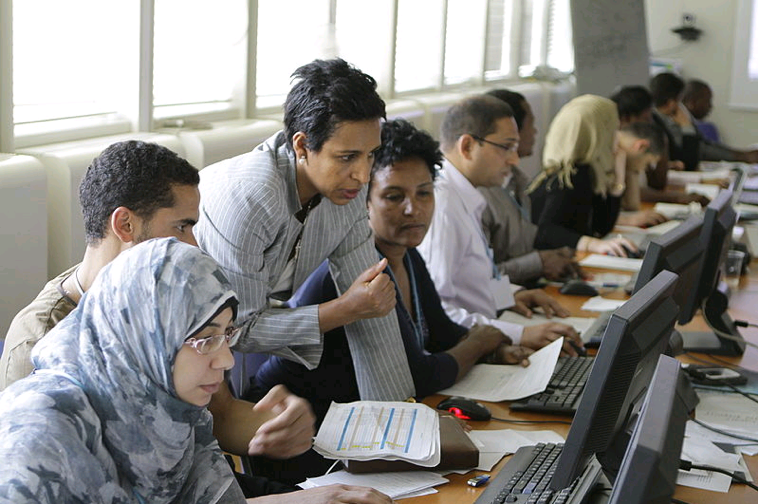It’s a common practice of most talented employees to look for better jobs that offer not just higher monetary benefits, but also better emotional benefits. Losing such valuable assets can pose a threat to your organisation, and more often than not, replacing the talent can be quite a challenge.
CSR is a great approach to retain these invaluable assets and boost your company’s growth and success rates.
 What is CSR?
What is CSR?
CSR or Corporate Social Responsibility is a business concept that adds meaning to an employee’s day-to-day work. The concept spreads across various worldly elements including the environment, health and safety, human rights, contributions to a nation’s developing economy, and even working conditions within the country. Whether it’s for the benefit of the environment or to reduce poverty around you, CSR ensures longevity, sustainability and growth which is a rewarding aspect for your organisation.
The current generation is motivated by personal values linked to their career. While profit and business impact is critical to the company, through CSR, employees can also look to making an impact on the society through their regular work. This incorporates sustainability into the daily work process—a factor that can be effectively achieved through CSR. A convenient way to achieve this is just spending 2% of the profits, as CSR ensures tenability and promotes a healthy advancement in the company’s development.
How To Incorporate CSR?
Despite the mandatory rule to integrate CSR in a company’s work operations, many organisations have failed to do so, posing a risk to their own sustainability without even realising it.
Let’s take a quick look into how companies can be pushed into incorporating CSR in their policies.
- Setting The Right Mindset
An environment that encourages individual’s initiatives and also provides scope for employees to take some action can prove helpful in the long run. This not only helps retain top talent, but also helps your organisation meet the high expectations set for it by society. It also makes room for broader markets, ideas and innovation—even if in the smallest of aspects—that make your workflow efficient and faster.
By shifting the focus off of short-term goals to bigger social causes, you create an environment that values all the stakeholders involved and one that encourages several possibilities. The changed mindset ensures newer revenue streams, expanded core capabilities, and a competitive advantage in emerging markets—all aspects that increase the company’s success rates dramatically.

Feminism is a concept that has been a topic of concern for several decades now, and at a global level. Despite a drastic decrease in female infanticide, child marriages, child labour, and an increase in the education of the girl child, the number of women working in firms across the country are quite alarmingly low. 60% of the companies across the country have a proportion of less than 10% of female employees.
CSR can extend its aid in social causes by providing career opportunities to women. Providing support to women who are interested in enterprise formation, specially through financial, marketing, and training components is a simple step that could be taken towards women empowerment.
- Equality For The Differently Abled
A simple way to address the differently abled through CSR would be to hire talented individuals who are facing the challenge of disability. In fact, it’s one of CSR’s policies to include the differently abled as at least 10% of the entire workforce. This adds to the diversity of the company, which increases the company’s social impact. It also adds to the overall value and reputation of your firm, giving you the benefit of obtaining a multitude of clients, many of whom are sensitive to factors such as these. It is important for an organisation to provide for a challenged individual in not just social but also the legal aspects—which include unique policies, commitments, and actions that might vary from the regular system.
The motivation to engage in social activities does not depend on an organisation, but on each and every individual of the company who can spark a change—be it the CEO or the junior employee. Individuals within the company, who are constantly involved in the work processes, are in a convenient spot to gauge the company’s assets, network of resources, distribution channels, and market share. They can easily come up with innovative solutions for the challenges faced within the company, as well as other social obstacles that the organisation is likely to face.
Even simple ideas like reusing and recycling, or energy conservation drives within the company, are goals that employees can work towards in addition to their usual day-to-day tasks, which on the long run has a positive impact on CSR and your firm’s success.
The basic mandate of 2% of CSR integrated in your organisation enhances its reputation dramatically. It not only helps you support social causes, but also encourages an environment for innovation and expansion into new horizons, which eventually lead to retaining top talent and amplifying success rates within the organisation.
At Vardaan, we provide professional advice on CSR to corporate companies, NGOs, businesses, philanthropic entities, and social enterprises. We provide assistance through baseline studies, CSR compliances, impact assessment, and advice on social responsibilities and the option of the right programme and partners. At Vardaan, we also provide corporates access to our fund-raising capabilities, proposal writing services, impact reports, and capacity building advisory services to implement CSR seamlessly.
With a mission to do good for the society and enhance your firm’s returns, we emphasise on originality, respect, and an unbiased approach through our services. Our aim is to ensure that we are both, thought and action leaders in the world of CSR in India.
Hence this evening when your office shuts, CSR will ensure that your most valuable assets – Employees return & continue to work for your Company.
Image references:
 What is CSR?
CSR or Corporate Social Responsibility is a business concept that adds meaning to an employee’s day-to-day work. The concept spreads across various worldly elements including the environment, health and safety, human rights, contributions to a nation’s developing economy, and even working conditions within the country. Whether it’s for the benefit of the environment or to reduce poverty around you, CSR ensures longevity, sustainability and growth which is a rewarding aspect for your organisation.
The current generation is motivated by personal values linked to their career. While profit and business impact is critical to the company, through CSR, employees can also look to making an impact on the society through their regular work. This incorporates sustainability into the daily work process—a factor that can be effectively achieved through CSR. A convenient way to achieve this is just spending 2% of the profits, as CSR ensures tenability and promotes a healthy advancement in the company’s development.
How To Incorporate CSR?
Despite the mandatory rule to integrate CSR in a company’s work operations, many organisations have failed to do so, posing a risk to their own sustainability without even realising it.
Let’s take a quick look into how companies can be pushed into incorporating CSR in their policies.
What is CSR?
CSR or Corporate Social Responsibility is a business concept that adds meaning to an employee’s day-to-day work. The concept spreads across various worldly elements including the environment, health and safety, human rights, contributions to a nation’s developing economy, and even working conditions within the country. Whether it’s for the benefit of the environment or to reduce poverty around you, CSR ensures longevity, sustainability and growth which is a rewarding aspect for your organisation.
The current generation is motivated by personal values linked to their career. While profit and business impact is critical to the company, through CSR, employees can also look to making an impact on the society through their regular work. This incorporates sustainability into the daily work process—a factor that can be effectively achieved through CSR. A convenient way to achieve this is just spending 2% of the profits, as CSR ensures tenability and promotes a healthy advancement in the company’s development.
How To Incorporate CSR?
Despite the mandatory rule to integrate CSR in a company’s work operations, many organisations have failed to do so, posing a risk to their own sustainability without even realising it.
Let’s take a quick look into how companies can be pushed into incorporating CSR in their policies.
 Feminism is a concept that has been a topic of concern for several decades now, and at a global level. Despite a drastic decrease in female infanticide, child marriages, child labour, and an increase in the education of the girl child, the number of women working in firms across the country are quite alarmingly low. 60% of the companies across the country have a proportion of less than 10% of female employees.
CSR can extend its aid in social causes by providing career opportunities to women. Providing support to women who are interested in enterprise formation, specially through financial, marketing, and training components is a simple step that could be taken towards women empowerment.
Feminism is a concept that has been a topic of concern for several decades now, and at a global level. Despite a drastic decrease in female infanticide, child marriages, child labour, and an increase in the education of the girl child, the number of women working in firms across the country are quite alarmingly low. 60% of the companies across the country have a proportion of less than 10% of female employees.
CSR can extend its aid in social causes by providing career opportunities to women. Providing support to women who are interested in enterprise formation, specially through financial, marketing, and training components is a simple step that could be taken towards women empowerment.


 Be Relatable
To leave a place for communicating with the audience, stay adaptable. Make your story flexible by recording it in classified pieces so that it will be easy to mix and match.
Communication involves the packaging of ideas for diverse audiences and is an essential skill for agents of change. Far more nuanced than it appears, communication involves a broad range of techniques and strategies. Storytelling is one of them — but it’s a significant one.
Breaking systems and changing them takes a lot of work, and it can push anyone out of their comfort zone. The amazing thing about keeping a narrative in arsenal is this: people can shoot down your date or ideas, but one thing they cannot deny is the story.
Image References:
Be Relatable
To leave a place for communicating with the audience, stay adaptable. Make your story flexible by recording it in classified pieces so that it will be easy to mix and match.
Communication involves the packaging of ideas for diverse audiences and is an essential skill for agents of change. Far more nuanced than it appears, communication involves a broad range of techniques and strategies. Storytelling is one of them — but it’s a significant one.
Breaking systems and changing them takes a lot of work, and it can push anyone out of their comfort zone. The amazing thing about keeping a narrative in arsenal is this: people can shoot down your date or ideas, but one thing they cannot deny is the story.
Image References:

 As mentioned earlier, companies need to spend at least 2% of their net profit of the past 3 financial year on CSR activities. It’s the duty of the Board of Directors to ensure that the stipulated amount is being spent on CSR initiatives.
However, it’s important to note that if profit computation has been done under the Companies Act (1956), they needn’t be recomputed under the 2013 Act. Given below are the particulars as per Section 198:
In the process of computation, credit shall not be awarded for the following amounts:
As mentioned earlier, companies need to spend at least 2% of their net profit of the past 3 financial year on CSR activities. It’s the duty of the Board of Directors to ensure that the stipulated amount is being spent on CSR initiatives.
However, it’s important to note that if profit computation has been done under the Companies Act (1956), they needn’t be recomputed under the 2013 Act. Given below are the particulars as per Section 198:
In the process of computation, credit shall not be awarded for the following amounts:

 A baseline survey also helps in evaluating the future performance of NGOs by setting realistic indicators for achieving their future goals and targets.
An NGO might approach a corporate with a specific program in mind for which it requires funding. The corporate can then opt for a baseline survey to analyze and evaluate their program and take a final call on the sponsorship. Corporates can conduct these surveys even when not approached by an NGO and can reach out to one if they see favorable results.
Apart from helping a company pick an NGO to fund, a baseline survey can help in the following ways:
A baseline survey also helps in evaluating the future performance of NGOs by setting realistic indicators for achieving their future goals and targets.
An NGO might approach a corporate with a specific program in mind for which it requires funding. The corporate can then opt for a baseline survey to analyze and evaluate their program and take a final call on the sponsorship. Corporates can conduct these surveys even when not approached by an NGO and can reach out to one if they see favorable results.
Apart from helping a company pick an NGO to fund, a baseline survey can help in the following ways:

 Image source: www.wikimedia.org
Why capacity building is crucial in NPOs
Much like other businesses, non-profit organisations also need to focus on building the capacity of their entire system. To do this, it’s vital that the management and staff raise the importance of capacity building and bring it on par with programme development. But to do this, an extensive action plan to target the right sectors and build the correct skills over time needs to be implemented.
Image source: www.wikimedia.org
Why capacity building is crucial in NPOs
Much like other businesses, non-profit organisations also need to focus on building the capacity of their entire system. To do this, it’s vital that the management and staff raise the importance of capacity building and bring it on par with programme development. But to do this, an extensive action plan to target the right sectors and build the correct skills over time needs to be implemented.


 After the school tour, the Sandvine volunteers joined the entire school for assembly, which consisted of singing the official Shanti Bhavan school song, a virtue reading on compassion, the daily news presentation, and two songs by the Shanti Bhavan school choir.
Activities and Debates, Galore!
After the school tour, the Sandvine volunteers joined the entire school for assembly, which consisted of singing the official Shanti Bhavan school song, a virtue reading on compassion, the daily news presentation, and two songs by the Shanti Bhavan school choir.
Activities and Debates, Galore!
 The volunteers then split into groups and picked different grades for their classroom workshops. Beginning with Kindergarten through 4th grade, the Sandvine volunteers conducted anorigami workshop, while the 6th through 9th graderslearnt about the steps of product development, right from the initial idea to finished product. The 10th – 12th grade students participated in a group discussion at the library, lead by two Sandvine volunteers. The discussion was so engaging the students and volunteers continued debating until almost past lunch time! One of the topics discussed was whether the government should have a role in monitoring the media.
What’s an eventful day without some football?
The volunteers then split into groups and picked different grades for their classroom workshops. Beginning with Kindergarten through 4th grade, the Sandvine volunteers conducted anorigami workshop, while the 6th through 9th graderslearnt about the steps of product development, right from the initial idea to finished product. The 10th – 12th grade students participated in a group discussion at the library, lead by two Sandvine volunteers. The discussion was so engaging the students and volunteers continued debating until almost past lunch time! One of the topics discussed was whether the government should have a role in monitoring the media.
What’s an eventful day without some football?
 As the workshops were going on, the 11th and 12th grade Shanti Bhavan boys played a difficult match against a fierce team of Sandvine volunteers. The Shanti Bhavan boys ended up pulling through with a win, 6-3, despite the strength of their competitors!
Lunch and goodbyes!
Everyone gathered for lunch in the dining hall to complete a wonderful morning of activities, and fun! Shanti Bhavan served a delicious lunch of puri, cashew rice, raita, daal, and kesari bath. Before departing, the Sandvine volunteers made a generous donation to Shanti Bhavan, which included books for the school library, clothing and games. The Shanti Bhavan students bade farewell to the volunteers, eagerly awaiting their next visit!
As the workshops were going on, the 11th and 12th grade Shanti Bhavan boys played a difficult match against a fierce team of Sandvine volunteers. The Shanti Bhavan boys ended up pulling through with a win, 6-3, despite the strength of their competitors!
Lunch and goodbyes!
Everyone gathered for lunch in the dining hall to complete a wonderful morning of activities, and fun! Shanti Bhavan served a delicious lunch of puri, cashew rice, raita, daal, and kesari bath. Before departing, the Sandvine volunteers made a generous donation to Shanti Bhavan, which included books for the school library, clothing and games. The Shanti Bhavan students bade farewell to the volunteers, eagerly awaiting their next visit!

 A company’s CSR vision and mission should be added within the very framework of the company to make a substantial change in the socio-economic and environmental challenges that society faces. To achieve this you might need assistance in areas such as environmental impact assessments, social audits, and the measurement of social incomes when it involves third parties. Also various intervention programs for stakeholders need to be partnered with Non–profit & social impact organisations. Herein, it is smart to hire consultants who are thoroughly familiar with the terms and working under CSR. One such firm spearheading the CSR revolution is Vardaan Advisors Pvt Ltd.
Here are the services provided by Vardaan to companies looking to maximise the impact of their CSR activities.
Social Responsibility Advisory
Vardaan’s social responsibility advisory board has ample experience in the industry and will help your business execute or improve their social responsibility programs. We help you create a smarter system to formulate the assessment of protocols and tools. We will assist you with risk analysis, training and education, monitoring, and program management. Our experienced team will help you conduct in-depth research that brings to light key insights to make critical decisions dealing with sourcing and positions as the leader in the supply chain.
CSR Compliance
We offer compliance services in order to understand if your business is aligned with the Companies Act of 2013. Companies that fall under the conditions laid down by this law are required to spend 2% of their profits on CSR and in case they don’t, they will be held accountable for it. We aim to help you with the preparation, implementation, and monitoring the compliance of your program with Section 135. We will assist in implementing a program that is integrated with your value chain, strategic, and is tailored for your business reporting.
Baseline Studies
A baseline assessment is a necessary process to study the existing state of your projects, the business, culture, people, and the demographic information of the village or town that you have chosen to run your CSR project. This assessment will take place before you can start off your program. We will help in gathering information that can strengthen and sustain your program. By carrying out research by collecting data from Government records, relevant articles from the Associated Chambers of Commerce and Industry. We also help you raise awareness about the program via social media, create a clear research design, validate the collected data, and have frequent interactions with your field teams to provide relevant, first-hand information to them.
Assessment of CSR spend
Before you can even start a CSR program, the first step is to consolidate your finances. We offer services to assess the correct bracket for your company’s spending for sustainable CSR. We will help you plan your activities in compliance with Section 135 (1) of the Companies Act 2003.
Recommending the right program and implementing partner
A trustworthy partner who has direct access to your company’s beneficiaries is the key to a successful program. When you assign the servicing of your CSR program, we will also help you find specialised partners to strengthen your program. It is necessary to completely verify the reliability of these partners. We aim to look for partners who have had a positive impact on the society through their programs.
Impact Assessment
Evaluating how effective your current CSR programs are is one of the most important steps towards creating a CSR campaign that actually works. Once the project has been implemented, we will undertake the assessment of the program while engaging with our external partners. These studies will take place at regular intervals. Through these studies, our team will analyse each project and the impact assessment report will be submitted to the board.
We use a diverse range of research tools and methods, depending on the nature of the program and the profile of our clientele. These tools range from interviews to answering questionnaires and will reveal what impact the program has made.
Vardaan’s main aim is to help our corporate clients implement effective and sustainable CSR programs that create a significant difference in the society. This way we help you and help ourselves give back more to the world than we could’ve ever imagined.
A company’s CSR vision and mission should be added within the very framework of the company to make a substantial change in the socio-economic and environmental challenges that society faces. To achieve this you might need assistance in areas such as environmental impact assessments, social audits, and the measurement of social incomes when it involves third parties. Also various intervention programs for stakeholders need to be partnered with Non–profit & social impact organisations. Herein, it is smart to hire consultants who are thoroughly familiar with the terms and working under CSR. One such firm spearheading the CSR revolution is Vardaan Advisors Pvt Ltd.
Here are the services provided by Vardaan to companies looking to maximise the impact of their CSR activities.
Social Responsibility Advisory
Vardaan’s social responsibility advisory board has ample experience in the industry and will help your business execute or improve their social responsibility programs. We help you create a smarter system to formulate the assessment of protocols and tools. We will assist you with risk analysis, training and education, monitoring, and program management. Our experienced team will help you conduct in-depth research that brings to light key insights to make critical decisions dealing with sourcing and positions as the leader in the supply chain.
CSR Compliance
We offer compliance services in order to understand if your business is aligned with the Companies Act of 2013. Companies that fall under the conditions laid down by this law are required to spend 2% of their profits on CSR and in case they don’t, they will be held accountable for it. We aim to help you with the preparation, implementation, and monitoring the compliance of your program with Section 135. We will assist in implementing a program that is integrated with your value chain, strategic, and is tailored for your business reporting.
Baseline Studies
A baseline assessment is a necessary process to study the existing state of your projects, the business, culture, people, and the demographic information of the village or town that you have chosen to run your CSR project. This assessment will take place before you can start off your program. We will help in gathering information that can strengthen and sustain your program. By carrying out research by collecting data from Government records, relevant articles from the Associated Chambers of Commerce and Industry. We also help you raise awareness about the program via social media, create a clear research design, validate the collected data, and have frequent interactions with your field teams to provide relevant, first-hand information to them.
Assessment of CSR spend
Before you can even start a CSR program, the first step is to consolidate your finances. We offer services to assess the correct bracket for your company’s spending for sustainable CSR. We will help you plan your activities in compliance with Section 135 (1) of the Companies Act 2003.
Recommending the right program and implementing partner
A trustworthy partner who has direct access to your company’s beneficiaries is the key to a successful program. When you assign the servicing of your CSR program, we will also help you find specialised partners to strengthen your program. It is necessary to completely verify the reliability of these partners. We aim to look for partners who have had a positive impact on the society through their programs.
Impact Assessment
Evaluating how effective your current CSR programs are is one of the most important steps towards creating a CSR campaign that actually works. Once the project has been implemented, we will undertake the assessment of the program while engaging with our external partners. These studies will take place at regular intervals. Through these studies, our team will analyse each project and the impact assessment report will be submitted to the board.
We use a diverse range of research tools and methods, depending on the nature of the program and the profile of our clientele. These tools range from interviews to answering questionnaires and will reveal what impact the program has made.
Vardaan’s main aim is to help our corporate clients implement effective and sustainable CSR programs that create a significant difference in the society. This way we help you and help ourselves give back more to the world than we could’ve ever imagined. 
 The change in law is alerting the corporate segment of India to its wider social responsibilities. Bimal Arora, chair of the Delhi-based Centre for Responsible Business, argues that “the so-called 2% law has brought CSR from the fringes to the boardroom”. Companies, he says, now have to think seriously about the strategies, timelines, and resources needed to meet their legal obligations.
The corporate world, especially in India, has already embraced CSR. Ever since the law was passed, companies have been disclosing environmental and social performance with financial results, which, before the mandate, was practically unheard of.
For example, the Sir Ratan Tata Trust recently gave the Azim Premji foundation $2 billion—the largest philanthropic gift in India. Instances such as this are the reason that some believe the law is a solid one.
Additionally, reports say that last year, a combined net profit of Rs. 4,37,167 crore was gained by listed Indian companies. 2% of this number will yield slightly less than $2 billion a year as a total CSR-spending amount. With such a huge amount produced every year, many of our environmental and social issues are bound to alleviate.
The Law has ensured that there is accountability from the non-profit sector. This will result in non-profits being run on professional lines leading to overall efficiency and impact creation.
The 2% law will ensure sustainability for projects, which was a dire need in the impact & development sector.
The change in law is alerting the corporate segment of India to its wider social responsibilities. Bimal Arora, chair of the Delhi-based Centre for Responsible Business, argues that “the so-called 2% law has brought CSR from the fringes to the boardroom”. Companies, he says, now have to think seriously about the strategies, timelines, and resources needed to meet their legal obligations.
The corporate world, especially in India, has already embraced CSR. Ever since the law was passed, companies have been disclosing environmental and social performance with financial results, which, before the mandate, was practically unheard of.
For example, the Sir Ratan Tata Trust recently gave the Azim Premji foundation $2 billion—the largest philanthropic gift in India. Instances such as this are the reason that some believe the law is a solid one.
Additionally, reports say that last year, a combined net profit of Rs. 4,37,167 crore was gained by listed Indian companies. 2% of this number will yield slightly less than $2 billion a year as a total CSR-spending amount. With such a huge amount produced every year, many of our environmental and social issues are bound to alleviate.
The Law has ensured that there is accountability from the non-profit sector. This will result in non-profits being run on professional lines leading to overall efficiency and impact creation.
The 2% law will ensure sustainability for projects, which was a dire need in the impact & development sector.
 Before the mandate, CSR was already a voluntary part of the various business groups and corporations in India. For example, IBM had worked with the Tribal Development Department of Gujarat as a part of its Corporate Service Corps Programme. They aimed at the upliftment of the tribal people in the Gir forests. The Tata Group, also, performed a range of CSR activities such as providing family planning and health services. Additionally, they organised several relief programmes for natural disasters. Reliance Industries Limited, too, has launched ‘Project Drishti’, a country-wide initiative that helps the visually challenged people of the economically weaker section of society restore their eyesight.
Thus, some believe that the compulsion to undertake CSR activities can be mainly questioned on the grounds that it is inherently contradictory. The law, say some, is ineffective on the basis of practical application.
The 2% law is viewed as an additional tax on Corporates. Alternatively there are no tax exemptions provided on the CSR spend.
In addition, some believe that the law does not lay any provision in regards to enforcement—there are no penalties for non-compliance.
Furthermore, the mandate contains many loopholes that have raised concerns. Since the government has failed to show any specific objective or purpose for the law, many Indian businesses and companies see the 2% provision as unnecessary and impractical. These businesses wish such initiatives were still a voluntary step.
In conclusion, there are clear pros and cons, and the effectiveness of the law is ultimately decided by both the givers and the doers.
References:
Before the mandate, CSR was already a voluntary part of the various business groups and corporations in India. For example, IBM had worked with the Tribal Development Department of Gujarat as a part of its Corporate Service Corps Programme. They aimed at the upliftment of the tribal people in the Gir forests. The Tata Group, also, performed a range of CSR activities such as providing family planning and health services. Additionally, they organised several relief programmes for natural disasters. Reliance Industries Limited, too, has launched ‘Project Drishti’, a country-wide initiative that helps the visually challenged people of the economically weaker section of society restore their eyesight.
Thus, some believe that the compulsion to undertake CSR activities can be mainly questioned on the grounds that it is inherently contradictory. The law, say some, is ineffective on the basis of practical application.
The 2% law is viewed as an additional tax on Corporates. Alternatively there are no tax exemptions provided on the CSR spend.
In addition, some believe that the law does not lay any provision in regards to enforcement—there are no penalties for non-compliance.
Furthermore, the mandate contains many loopholes that have raised concerns. Since the government has failed to show any specific objective or purpose for the law, many Indian businesses and companies see the 2% provision as unnecessary and impractical. These businesses wish such initiatives were still a voluntary step.
In conclusion, there are clear pros and cons, and the effectiveness of the law is ultimately decided by both the givers and the doers.
References:

 The backbone of every society is education. But what weighs the most is the quality of education. In India, out of the 239 million students enrolled for classes I – XII, only a handful receive the quality education with qualified teachers and education aids. UNICEF states that 40-50 percent of the children from 16-18 years are dropping out of schools to go on to becoming child laborers denying themselves access to quality education.
The Indian corporate sector has a big opportunity to play an impactful role in changing this by adopting different ways to improve the quality of education.
The backbone of every society is education. But what weighs the most is the quality of education. In India, out of the 239 million students enrolled for classes I – XII, only a handful receive the quality education with qualified teachers and education aids. UNICEF states that 40-50 percent of the children from 16-18 years are dropping out of schools to go on to becoming child laborers denying themselves access to quality education.
The Indian corporate sector has a big opportunity to play an impactful role in changing this by adopting different ways to improve the quality of education.